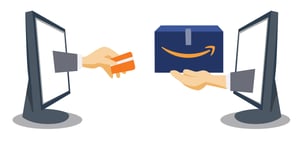Originally published on August 30, 2022, updated May 19, 2023
Menu
Join Our Email List
- Receive our monthly newsletter.
- Stay up to date on Amazon policies.
- Get tips to grow your business.
When looking to “be your own boss” or nab an extra income stream, many entrepreneurs turn to Amazon for opportunities. With an estimated 6 million sellers, it’s easy to see why so many businesses jump on board. But like any business venture, it’s not without risk and it’s not necessarily easy to start making money.
So, how can you become profitable? What does it take to make sure your Amazon store stays successful?
As an experienced agency supporting vendors and sellers all over the globe, eCommerce Nurse has seen and dealt with it all. Want to get answers to these questions and more? In this article, we'll provide answers to common Amazon seller FAQs. Let's get to it!
Unfortunately, there is no one-size-fits-all answer to this Amazon FAQ. Many sellers routinely make at least $1,000 a month in sales, but other sellers make more than $100,000 a month, which might mean anywhere from $12,000 a year or $1.2 million in annual sales. What is “worth it” for one business may not mean much for another. It truly depends on the structure of your business and the products you sell.
That being said, as we’ve worked with businesses in all categories and in all stages of selling, there are a few guiding principles that make an idea more profitable and easier. Georgina Saxby, eCommerce Nurse’s Senior Client Success Manager, sums it up nicely:

These days, Amazon can be worth it if you also sell off-Amazon, or your product is very unique, or has a high margin. The reason is, fees are high and as a brand, it's important to have a presence on Amazon. But unless you have a high enough margin and minimal competition, or a very unique product offering, it is difficult to make money versus the effort involved.Georgina Saxby
In short, Amazon fees and competition are always steadily increasing. If you can’t sell your products to make a decent enough profit, it’s likely not worth it.
 Anecdotally? Crocs shoes. While this is a joke, it’s also truthfully illustrative of a few things. First, the landscape of Amazon is always changing. From butt-lifting leggings made popular by influencers to the latest stainless steel water bottle, it’s impossible to know what will strike as the next big thing.
Anecdotally? Crocs shoes. While this is a joke, it’s also truthfully illustrative of a few things. First, the landscape of Amazon is always changing. From butt-lifting leggings made popular by influencers to the latest stainless steel water bottle, it’s impossible to know what will strike as the next big thing.
Second, some categories are always popular on Amazon, such as cookware and electronics. Customers often trust Amazon for staples (such as spatulas or sheets where they can select the best-reviewed item) and long-time faves (such as an XBOX or iPhone).
You can always check the Best Seller rank and drill down into any category. But the point is, Amazon has millions of items. Unless you research and find an untapped niche, unique product, or can make something so cheap that it’s irresistible, you will have a hard time outpacing the big sellers and manufacturers that have been in the game for decades.
When doing product research or scouting out suppliers, many newbie sellers have big, initial ideas about products that will make them instant millionaires. But as someone who has worked with Amazon for 15 years and seen it all, there are a few things you should know about what products shouldn’t be sold on Amazon in 2022.
While Amazon used to be more of a retail-arbitrage Wild West, this is no longer the case. Being successful on Amazon will likely require Brand Registry status and brand ownership on your part. There are also a lot more restricted products, gated categories, and fine print about what you can and cannot claim.
In general, there are more restrictions for products if a business is going to claim something like organic certification, FDA approval, and dangerous goods. You'll want to carefully consider this before deciding to sell something. Even selling items for babies or consumables can be fraught with more loopholes than many will want to deal with.
The easiest products to sell will be items in ungated categories where you are the brand owner with a registered trademark. You’ll also want to avoid anything large and bulky that requires complicated shipping or storage space. When it comes to shipping and storage, ensuring that nothing is going to be damaged easily, either by melting or breaking, is paramount. In general, anything with expiry dates (from Covid tests to artisanal olive oil) is going to be more complicated to sell on Amazon.
Technically, businesses are not required to have a business license in order to sell on Amazon or online as an eCommerce operation. But because business requirements for operation do work at a state level, you need to comply with local laws for your home state.
A business license will be a document granted by the city, county, or state that gives you the approval to operate. To avoid any tax issues, Amazon seller account suspensions, or surprises, we highly recommend you consult with a business lawyer about options related to your specifics. For example, selling one type of sporting good from Maryland that is your own invention will be very different from operating a retail arbitrage business from your garage in Texas.
This one comes up in every Amazon selling FAQ. It should be clear by now that Amazon is not a one-size-fits-all platform. Costs for your Amazon business will be dependent on your business size, product type, margins, sourcing needs, fulfillment methods, long-term goals, and more.
If you're starting from scratch as a brand-new business with no existing supply chain (like if you're not a former brick-and-mortar seller), your investment will be higher.
But at a basic level, an Amazon Professional selling account will cost you just $39.99 per month in the US. If you’re registering with the Brand Registry, you'll need to register for a trademark for roughly around $350. This will get the ball rolling on your Amazon account, but you’ll also need to source a product, import it, and find a way to get it to customers.
Many businesses will choose Fulfillment by Amazon (FBA) for its vast network of warehouses, but this means Amazon will also charge you fees for every sale. The amount will depend on the category, price, and size of your item. Physical space requirements for product storage can be vastly different, and Amazon will calculate this down to the inch and dollar. Amazon supplies a revenue calculator, which makes it easy to estimate your fees and costs.
 In general, Amazon professional sellers get paid every two weeks. But this can be complicated by the actual shipping and delivery dates of the products sold in the previous 14-day window. It also may take up to 5 days for the money to appear in your bank account (we recommend setting up direct transfer to expedite this).
In general, Amazon professional sellers get paid every two weeks. But this can be complicated by the actual shipping and delivery dates of the products sold in the previous 14-day window. It also may take up to 5 days for the money to appear in your bank account (we recommend setting up direct transfer to expedite this).
Other costs, such as chargebacks or advertising fees, can also result in less money arriving than you expected. For more information on actual disbursements related to your account, visit your Payments reports in Seller Central. For more information about what might be held out of your payments, visit Amazon’s help page on Account Level Reserves.
The sky's the limit when it comes to selling on Amazon, but with a wealth of opportunity and information can also come a lot of confusion. This article touched on some very basic Amazon seller FAQs for those new to the Amazon space. We hope this puts you on the right track on your Amazon journey. If you have more questions or need assistance selling on Amazon from anywhere in the world, contact the experts at eCommerce Nurse.
Originally published on August 30, 2022, updated May 19, 2023
This post is accurate as of the date of publication. Some features and information may have changed due to product updates or Amazon policy changes.
These Stories on Amazon
14321 Winter Breeze Drive
Suite 121 Midlothian, VA 23113
Call us: 800-757-6840





Copyright© 2007-2025 eComEngine, LLC. All Rights Reserved. eComEngine®, FeedbackFive®, RestockPro®, and SellerPulse® are trademarks or registered trademarks of eComEngine, LLC. Amazon's trademark is used under license from Amazon.com, Inc. or its affiliates.
No Comments Yet
Let us know what you think